So I think this is going to be a long one, given the number of questions that came in this week and the number of things I set up to talk about beforehand. But before we get into that, let’s hit some preamble.
Dan Buckley is a name that most fans in and around the industry don’t really know. That’s because, even moreso than the editorial staff, Dan isn’t front-facing. His name is in books but he’s not a presence there or on the convention trail or giving interviews in the manner that most of the rest of us are. But Dan oversees the entirety of Marvel’s publishing operations among many other things, and he’s truly excellent at his job. A little bit of it is maybe some game-recognizes-game, but Buckley’s ability to read people and analyze and understand their motivations and what drives them is uncannily keen. It’s similar enough to the skills that I often use to convince people—creators or other editors or whoever—to do whatever I need to get done, so I can recognize the ability in use, even when it’s being turned upon me. So I wound up having a meeting with Dan this week, one in which he told me he was going to ask me to do something that I wasn’t going to want to do, and then proceeded through a combination of need, flattery, genuine admiration, duty and responsibility to get me to agree to take on the specific mission that he was hoping to entice me into. Seriously, I know something about pitching an idea to people, and this was like watching a world class hurler throw a perfect game.
So August 1, 2023 was the day it all changed. We’re not ready yet to say anything more about what this is or what’s coming next, but it’s all pretty exciting. It’s been keeping my brain whirling with ideas and concepts enough to where it’s disrupting my sleep cycle in a big way, which had better calm down soon or I’m not going to be in any shape to carry out the mission. There’ll be more to come in the days ahead, likely sooner rather than later as I begin the process of constructing my machine and getting things moving. I’m sorry this is all so mysterious and teasing, but I wanted to share at least the moment of it while it still feels a bit electrifying. Who knows, it could all be downhill and into the dirt from here. But it won’t be. Because my team and I, we’re going to annihilate it.
And now, this:
Questions! You got ‘em, I answer ‘em, you don’t walk away any more illuminated. What a process, right? So here we go!
Matthew
Prompted by the final issue of Hellcat, is there a reason why a fifth and final trade paperback for Cantwell's Iron Man run has never materialized?
This is a pretty good question, Matthew, but the answer is even simpler than you might think. The reason is because the entirety of Christopher Cantwell and Cafu’s run on IRON MAN was collected across the four existing volumes—there isn’t anything more for us to collect!
Jess Nevins
well OBVIOUSLY my theory about the Shogun Warriors' plots being deliberate metaphors for the Carter administration & the pre-Reagan national malaise are NOTHING BUT THE TRUTH how dare you call it a conspiracy EVERYONE AT MARVEL WAS IN ON IT
Certain truths are self-evident, Jess.
Paul Constant
You write, “it now typically takes an artist around six weeks to do a book.” Has Marvel ever tried an every-six-week publishing schedule to better accommodate the modern rhythms of drawing a comic? I know there were a few bimonthly books back in the 1970s, and I assume they weren’t successful in holding readers’ interest. But I’d be willing to wait the extra two weeks if it meant an artist could have an unbroken run on a book.
We have tried this on more than a couple of occasions. Paul, and what we’ve found is that in every case, it’s got a detrimental impact on sales. More than a month, and readers simply wander away, having lost track of the story and figuring that any further installments are not going to be forthcoming—and even if they are, they can simply catch up when the whole thing is completed and collected. The conditions that made a bimonthly title viable back in the day—that it would remain on sale for two months and therefore be around on stands to potentially be sold for longer—doesn’t really work that way in the modern Direct Market. Even beyond comics, there are just too many pieces of potential entertainment competing for a reader’s attention, time and money.
Jeff Ryan
There’s a standard assumption that a crossover issue of a comic (especially a comic without robust sales) may have been suggested/forced up on them by editorial, in order to bolster sales. Have there been cases of the opposite, though? Where a writer wanted to steer their comic into an upcoming crossover, but the editor nixed it?
There have been such occasions, yes. More often than somebody who’s working on an ongoing title, though, this more readily tends to occur with people who might pitch different tie-in stories or projects that are additive to our publishing plan. We do a certain number of those typically, but there is an overall sense of how deep the “footprint” of a project can be before you hit diminishing returns, so we don’t want to go forward with any tie-in material that we don’t think will help to sell the overall concept of whatever Event we happen to be doing.
Bojack Norseman
Speaking of last minute changes and/or the conspiracy belief in them, I wonder if you can speak to the way they Secret Empire changed, or didn't, from say issue 1 of the event to the finale. It certainly felt like there were things set up and teased, both within the comic and in promos, that didn't quite match the end. But perhaps it's a boring example of the story evolving organically and well in advance, rather than in response to criticism.
Medium length side tangent: I think one reason people beleive in conspiracy theories is that there really *are* examples of events which people in power attempt to cover up. I would argue this happens in comics even - things do change behind the scenes, and the public doesn't always get the full or honest story as to why. Now, there are often good and reasonable reasons for these changes, and even reasons for not being fully transparent with the public. But it does engender suspicion.
As an example, I think about the way in which Fantastic Four was sidelined, and a strong denial from Marvel that such was happening. I don't k ow if anyone was open about why Inhumans were given greater prominence, though everyone suspects it was for the Disney/Fox reasons.
Well, Bojack, it’s a dull answer but there really weren’t any big changes to SECRET EMPIRE along the way, apart from the story ballooning such that we had to add on a batch of SAM and STEVE CAPTAIN AMERICA tie-in issues on the fly to absorb some of what Nick wanted to do. And Spencer did have a tendency to turn in scripts that were longer than the issues we were slated to do, occasionally requiring some truncating. Looking back on it, that SECRET EMPIRE storyline is massively huge, encompassing a dozen central issues before you even get into the question of tie-ins. Ambition was not one of its problems. Speaking of SECRET EMPIRE, Jose, the guy whose retrospectives of classic television shows videos I plugged a few weeks back did one on the whole of SECRET EMPIRE a few years ago, and having watched it, I think it’s pretty great. So if you’re interested, it can be found here. Be forewarned, though, it’s like an hour and three-quarters long—which is almost half as long as SECRET EMPIRE itself.
On the question of things like the benching of the Fantastic Four and the push on Inhumans, I feel like in both cases I’ve been reasonably consistent in my answers over the years, despite the fact that people uninvolved in the business in any way don’t seem to want to believe those answers. And that’s their choice, surely—but it doesn’t make them any less true. In most of these cases, there are often multiple factors that play into why a given decision might be reached, it’s rarely as cut-and-dried as the average fan would like things to be.
JV
yeah I wonder what Rick Remender’s original plans for Hydra were (Misty Knight seemed to be a Hydra agent and hinted there were more traitors about). Anything you can share Tom?
I don’t really remember Rick having any specific plans for Hydra beyond using them more, JV. I have no doubt that he had a bunch of thoughts, but it may have simply been that we never got to the point where those needed to be discussed with me. Or I could simply be forgetting them—it’s been a long time and that’s a question about stories that didn’t see print, so I don’t know why I might remember that apart from me simply remembering it.
Tim Pendergast
On the topic of late books, I have always wondered why companies don't get more issues in house before publishing, especially for crossover events. With the Dreaded Deadline Doom a thing of the past this would make sense.
This is an oft-quoted bit of fan wisdom, Tim. It’s one that comes up month after month from people. But clearly you must see that there’s a reason why this sort of thing doesn’t always work. First off, not to knock anybody, but there are creators who will take as much time as there is to take. They need to feel the wall at their back to motivate them to produce, so telling them that we’re going to start banging out issues months ahead is a good way for deadlines to start getting missed because they aren’t “real” deadlines in the first place. The flipside of that is really the question How Many Is Enough? Speaking to two projects of mine that I can talk about here, for the upcoming launch of G.O.D.S., Jonathan Hickman and Valerio Schiti are presently done with three issues and Valerio is drawing the fourth—that’s before the first issue comes out, and also takes into account that the first issue is something like 70 pages long. S it’s ahead, but is it ahead enough? The first issue will reach stands in something like a month and a half from now, with the second issue following a month behind that, and the third the same. So suddenly, all of that comfortable lead time that’s been built up is going to fall away like chunks off a melting iceburg, and suddenly Jonathan and Valerio and colorist Marte Gracia and me and my staff will again be feeling the pressure. On another project-to-for-the-moment-remain-nameless, which is next year’s big Marvel Event series, our killer artist is already drawing the first issue, a comic book you won’t see until next May. But is that enough? These will be larger-than-normal size issues, mostly, and they’re going to be shipping at greater than a monthly frequency. So again, we’re going to eat through a ton of prep time in no time at all once we start sending things to print. And the adjunct to that is, if these examples aren’t enough, then how could you possibly start far enough out to insure that it is enough? You could just not schedule a project—but that means that, while creators may work on it, they’re going to be more focused on stuff that is more immediately due. We’re about to announce a project that has been in the works for, no lie, seven years. It’s completely drawn, every one of its oversized issues. But none of the covers have been done yet, and the cover concepts that we worked out and sketched out years ago don’t feel right anymore, not for the marketplace we’re in now. So there’s still going to be something of a race to the finish line for that series, even though I currently have something like 180 pages of it literally completed on my Marvel server. How much is enough? Answer: nothing ever is!
Radamax
You buried the lead on the Kevin Maguire story. WHY did he only do one issue of Cap? I don’t remember any other high profile book he worked on after that.
Kevin didn’t do only one issue, Radamax, he did two full issues and a part of the third. But what I talked about just above is exactly what happened. THE ADVENTURES OF CAPTAIN AMERICA didn’t have a real publication date or a real deadline, and Kevin was never the most disciplined artist in terms of delivery, in part because he was meticulously detail-oriented in his pages. So when the decision was made to publish the book in 1991 for Cap’s 50th anniversary—a full two years after I put that hole in that page as an intern—Kevin wasn’t able to get it finished in time. And now that it had been scheduled, the editor in question had little choice but to bring in other hands to complete the project. How much is enough?
Montana Mott
Hi there! A few weeks back, you mentioned "Today, when fans enthuse about the wonderfulness of YOUNG AVENGERS, most often they’re speaking about Kieron and Jamie’s work, rather than Allan and Jim’s."
Interestingly, within my own lens of Young Avengers fandoms I follow online, I usually get the opposite impression. However, whether these be circles of twitter followers, tumblr pages, blogs, or comic forums, they are all a bit skewed and echo-chambery in various ways. This made me wonder:
I know at the end of the day money is the most important indicator for any business, but does Marvel editorial typically track or measure sentiment around the reception of different comic book runs in online spaces? I work in the video game industry, and large game studios tend to have community engagement or social media teams that grab lots of data from various social media(s) to see how fans are reacting to or anticipating various, even specific things about games and franchises. Do Marvel comics do anything like that? I suppose one avenue of gauging feedback I'm aware of is through your various office emails such as mheroes.
Not really, Mott. We don’t have anywhere near that manpower that would be required to do such a thing for everything that we put out. And, honestly, the online reaction from fans is often deceptive. I tell our younger editors constantly that the feedback they see online or in the mail we get is nice, but the thing to really pay attention to is the customer’s dollars. It’s a lot easier to say that you’ll buy something than it is to actually put your money on the counter and buy it. And the reverse is true as well. If you’re super-irritated at something and vow to never again purchase a Marvel comic ever, ever, ever until it’s fixed, what are the odds that you will actually follow through on your threats? Some will, but not everyone. What the audience does is more important than what they say. As was proved by SECRET EMPIRE, or more currently by all of those Spider-Man fans upset about recent storylines. Lots of people are complaining and telling us that “everybody” hates the book and the direction and Zeb Wells and Nick Lowe ( I can’t argue with that last one.) But month after month, it continues to be our best-selling regular title. So given that, which should we pay heed to, the irate yelling or the cash in the register?
Jack Elving
Mr. Brevoort. Fundamentally I think there's a larger issue at hand. One I think you can appreciate as a comics scholar yourself. You have written countless notes and commentary on old comics going into detail on various behind the scenes notes and concepts. You were able to do so owing to the diligence of comics scholars in the past on one hand, but primarily to the greater accessibility and candor of people working behind the scenes.
Since 2008 or so (coinciding with the Marvel Disney purchase which might or might not be the explanation), there's been comparatively little data about the making of comics at Marvel in the same time frame. Primarily the only information at hand is various PR spin and marketing diktats of the kind that would be inadmissible at an earlier time. There's very little transparency and candor from people involved behind the scenes. In the internet era it's a bit baffling for there to be more information behind the scenes about a story as old as The Night Gwen Stacy Died rather than one as recent as One More Day for example. The periods after that are similarly blank.
So in a certain sense, the current issue of competing claims about the Kamala Khan fracas feels self-generated. To some extent, it's ideal from a marketing perspective, where people raising doubts about the execution of a comics storyline can raise doubts but be dismissed as conspiracy theorists all the while the publisher is not in any obligation to provide real data to back its claims. Nor is there any information that is not open to any independent verification or double-checking. All that's left is the honor system, the expectation that Marvel Editorial can tell the truth, when editors and publishers of the past, great ones at that, in any comics continuity, have been noted fibbers. There's a profound expectation here that the current Marvel Editorial be regarded as the most honest, truest, highest in conduct on a level hitherto unseen. And I'm not sure this present response addresses that.
I gotta tell you, Jack, and I mean no disrespect by this. But I got a real laugh out of you writing to this Newsletter that goes into behind-the-scenes details in minute detail each and every week about a wide variety of things from the past three decades to complain that there’s no way to get behind-the-scenes details about the events of the past three decades. Having been a reader and a fan in the 1970s and 1980s, I have to tell you, you get a mountain more inside information and a lot more ready direct contact with the creators than we could ever have dreamed of back then. Also, if anybody has ever performed any independent verification on the events of The Dark Phoenix Saga, I’ve never heard about it. We know what we know because the people who were involved told us what had gone on at some point, and there were the work-products of the era and the printed comics themselves from which certain truths could be devised. But as the audience, you’re not entitled to know how the cake is made, any more than I was back in the day. The transaction is: you give me money and some of your time and I give you a story that you hopefully feel is worthy of both. And if you don’t, then next month you give me neither. Any backstage stuff isn’t a part of the compact at all—any more than it is with a TV show, a film or a novel or game. You might get some of that info if the people involved feel a desire to share, but it isn’t required. Does that make sense?
F. Mac
I think conspiracy theories around Amazing Spider-Man are a fired stoked both by some readers' wild imaginations and Marvel/Spidey editorial choosing to be a bit too confrontational towards the fact that the current run has a larger than usual amount of fans unhappy.
Then there have been some course corrections absolutely evident in the book: it started by telling us that Peter had done something so terrible, so unforgivable, that put him at odds with everybody and caused MJ to leave him. When we (finally!) got the full story, Peter had done pretty much nothing and MJ had just decided to move on with another guy just because. There is an absolute disconnect between how it was presented and how it was resolved.
And then there is the fact that Kamala was drawn in the resurrection scene without her usual facial features. She literally looks like a grown up white woman colored with a darker skin tone.
Look, I've never gave the character-switch narrative any credence, but if you put all this together then it becomes much less of a stretch than how you are presenting it.
I don’t work directly on the book, F. Mac, but I can tell you that the story you got in those recent issues is materially the same story that Zeb outlined to the Marvel creative and editorial staff when he began working on the book. So whatever course corrections you’re seeing are perhaps larger in your mind than they are in reality. I feel that if you just consider all of this from the perspective that Nick Lowe is a goon, it becomes a lot easier to realize that what you’re reacting to isn’t malice or course-correction, it’s simply incompetent bungling. Comics are made by humans, and often under tight deadline situations, and everybody works together to do the best job that can be done in that time. But no comic book in Marvel’s 70-plus years of existence has ever seen the light of day without at least one bone-headed mistake in it.
MADMan James
I was listening to Hey Jude from The Beatles the other day, and it's a song that maybe shouldn't work. It's a pop song that's over 7 minutes long and has an endlessly repetitive ending. I'm not sure if it's true, but I've read that even with as successful as The Beatles were, there was studio pushback about releasing it, and in the end, it turned out to be one of their biggest hits. Have you ever had a comic story like that? A supremely talented creator pitched an idea that really seemed to cut against the grain of what sells comic books, but due to their track record you acquiesced and it ended up being a hit?
I feel as though the answer here is “constantly”, but I don’t know that I have a good example off the top of my hear, James. But how about this: anybody on Earth would have told you for certain that it was going to be absolute death to not have Ultimate Peter Parker even put on a Spider-Man costume until the final page of issue #3 of that book. Issue #3! But it worked, and readers were into it, thanks to the skills that Brian Michael Bendis and Mark Bagley brought to the table. And there were big arguments about revealing or not revealing the origin of Wolverine before that story got done (the thing that convinced me that we had to do it was publisher Bill Jemas’ absolutely correct statement that, if we didn’t do it, then the people making the X-MEN movies would, and then we’d be stuck with whatever they came up with.) and while maybe that story doesn’t loom quite so large at the moment any longer, it was still a huge deal at the time. So I don’t know that this is quite the sort of examples you were looking for, but there you go. In terms of actual story content, I need to believe in the merits of what a writer is pitching before I can turn around and champion it. So if a crazy idea was pitched to me that I didn’t think would work, the likelihood that it would still happen is almost nil. So perhaps I’ve killed a bunch of “Hey, Jude”s along the way.
Sean Kelly McKeever
Something I've long been curious about: 2001's The Incredible Hulk #26 was shipped from the printer inside a clear polybag. No markings on the bag, nothing included with the comic, no mature content. Do you recall why?
I don’t even remember that it was, Sean, let alone why. I feel as though that wasn’t the case with the entire run, or even most of the run.
Carlos
I think Mr Lowe is doing an AWESOME job in Spider office and I am very Happy that my beloved Spider-Woman is in Gang War with a mini series, but Any chance that in 2024 Avengers office will have any plans for her?
Hey, somebody with something nice to say about Nick Lowe! Nice to hear from you again, Carlos. There are more plans for your favorite Spider-Woman in the future—but not in the Avengers office.
Pierre Navvarre
Was it always the plan to make the Captain Mar-Vell from Civil War: The Return a Skrull ?
No. Originally, that plotline was intended to be just what it looked like on the surface: the genuine Mar-Vell from the past pulled into the present before his cancer could kill him. But there was a whole saga around Captain Marvel during that period, one that I’ve spoken at least in part about in the past. The short version is that Brian Bendis and I wanted to turn Carol Danvers into Captain Marvel right after HOUSE OF M, but there were sudden concerns about any character who was going to so prominently carry the Marvel name in that way. So at one point, the notion was that we’d create a new Captain Marvel—a cornfed guy from the midwest. For more than a hot minute, this was going to be Gravity, Sean McKeever’s character who had debuted around there. This is why he got killed off in the series BEYOND!—he was going to be resurrected as the new Captain Marvel. But then that plan got sidelined (people realized that what they were building was essentially Captain America) which is why Dwayne McDuffie and I brought Gravity back to life in FANTASTIC FOUR shortly thereafter. And after a couple more false starts, which included this dogleg with the Mar-Vell from the past, eventually Steve Wacker was able to convince the powers-that-be to let him make Carol Captain Marvel, and the rest is history.
Yeah, man, there really isn’t anyplace to get gripping behind-the-scenes details that don’t sound like a press release anymore. I await the independent verification team.
Behind the Curtain
.We talked about the fact that a comic book that I worked on was going to be reissued as a replica edition, which I found a bit freaky. So this let me to excavate back into my files on this issue and dig out some specifics to share with you.
That’s the finished cover to ALL-NEW MARVEL NOW POINT ONE #1 above, by Salvador Larroca. It’s been long enough that I forget who might have colored it, sorry about that, colorist. Should have signed it, maybe.
And this above is the crummy mouse-drawn cover sketch that I put together and sent to Salva to show him what I thought the cover might look like. Fortunately, I labeled everything in nice big red letters, or else making heads or tails of this monstrosity might prove difficult. But it gets the idea across, right, and it looks like the finished cover except, you know, bad.
Here’s the sketch that Salva sent back to me, and that I approved to go ahead to pencils and inks.
And here is Salva’s final inked piece.
I also found some pencils in my files as well. So here’s an Adrian Alphona page from the issue, the first really good shot of Kamala Khan as Ms Marvel. Sana Amanat edited this story and did all of the block-and-tackle on it, I just slotted it into the final book.
And here’s Michael Allred’s pencils to the final page of the Siler Surfer pilot story that we did for this book in preparation for the series. That tangent between Dawn’s knee and the side of the surfboard is killing me looking at this—hopefully, we fixed that by the time the page was inked and colored.
Pimp My Wednesday
This is I believe the first week we’ll be running our tribute to the late John Romita in most of our books, a grandmaster of the first order.
But it’s not all tragedy and death in AVENGERS #4 by Jed MacKay and C.F. Villa. along with secret weapon color artist Federico Blee. Just mostly, as the Avengers split up around the globe to take on the threat posed by the otherworldly members of the Ashen Combine. The Avengers’ greatest strength lies in their ability to work together, so can they triumph over their extremely powerful foes one-on-one? We’ll see! And it’s all behind another beautiful cover by Stuart Immonen.
And in the digital space, Kate Bishop and Runa have located the entity responsible for the theft of several key Asgardian artifacts, including Thor’s hammer. Unfortunately, in order to deal with it, they’ll have to knock out the God of Thunder himself first. Associate Editor Annalise Bissa (hi, Mr. Bissa!) presents an AVENGERS UNLIMITED story by Kalinda Vazquez and Alba Glez. I only just learned that Kalinda had worked on the TV series PRISON BREAK back in the day, so going to need to talk about that with her at some point.
A Comic Book On Sale 55 Years Ago Today, August 6, 1968
If it wasn’t the absolute first, CAPTAIN ACTION was certainly one of the first comic books to be based on a toy. The Captain Action figure was a rival line to the incredibly popular G.I.Joe that had made its debut a few years earlier to dominate the boys’ market. The Captain needed a gimmick, and he got one: you could buy separate uniforms for your captain Action figure and transform him into a wide variety of other super heroes, including Batman, Superman, The Phantom, Sgt. Fury, Spider-Man and Captain America, among others. There was eventually also a villain figure, Dr. Evil, and a kid sidekick in the form of Action Boy. It’s a well-remembered line that’s been reissued in recent years. In any event, perhaps as a part of the licensing deal that granted Captain Action his Superman and Batman guises, DC wound up with the rights to produce a comic book series based on the character. Now, obviously, Captain Action wasn’t going to be able to transform himself into Spider-Man or Captain America or the Phantom inside the pages of a DC book, so a new origin and backstory had to be devised. Editor Mort Weisinger, head of the Superman line who had been tasked with developing the tie-in series, handed the job to his youngest writer, protégé and prodigy Jim Shooter. This would be the first series Shooter would ever launch from a #1, and also the first time he’d receive credit as a writer for his efforts. Most DC books of this period still only ran credits sparingly, but CAPTAIN ACTION #1 was illustrated by Wally Wood, who was skilled enough and intense enough that everybody gave him a bit of leeway. Wood credited himself as the artist and also Shooter as the writer, and nobody at DC dared his wrath by removing it. Shooter completely reinvented the character, giving him the powers of the gods of antiquity, each one embedded in a coin struck with the likeness of that deity. Captain Action was archaeologist Clive Arno, the widowed father of Carl Arno, who would take on the identity of Action Boy along with his father. The two first battled a rival who desired the coins for his own benefit and power, and thereafter Dr. Evil in later issues. Superman put in a rare guest appearance in the first issue, primarily to justify the cool Irv Novick cover image of Captain Action pushing his way past the Man of Steel to enter the fray. For a series based on a toy, CAPTAIN ACTION was really quite good, with later issues both illustrated and written by Gil Kane after the editorial assignment had changed offices. But the book only lasted for five issues in total, and was discontinued as the character disappeared from toy shelves.
Another Comic Book On Sale 55 Years Ago Today, August 6, 1968
This first issue of DC SPECIAL celebrated the work and career of the man who had just been promoted from cover designer to editorial director and who would soon become Publisher and President of National Periodical Publications, Carmine Infantino. It’s a relatively prominent step away from DC’s habit of keeping its creator names largely unheralded, but Carmine was now the boss, so who was going to object? The book reprinted Carmine’s first “New Look” Batman story, a flash tale that had won some fan awards, an Adam Strange adventure, a story from Strange sports Stories, and a Detective Chimp mystery—Carmine had always professed his love of working on that character. Later issues of this reprint series would be organized around an assortment of themes, but the fifth issue was a similar tribute to artist/editor Joe Kubert
A Comic Book On Sale 20 Years Ago Today, August 6, 2003
I indirectly caused SUPREME POWER to be created, though I had nothing to do with the actual series. It all started with the realization that Marvel’s title count had shrunken to a dangerous level. We typically would release somewhere between 60 and 70 titles, but at tour lowest point here, that number was something like 38, which meant that there was a danger of us not being able to cover our overhead on our offices and such. So there was a mad scramble to generate viable new titles that could be put into production and launched as soon as possible. Joe Quesada and Bill Jemas tasked the staff with coming up with as many ideas as we could. My team and I, which included Marc Sumerak and Andy Schmidt and possibly one or two other, threw ourselves into the task, coming up with a list of something like ten ideas for projects that we were excited about. I sent the list over to Joe, and he was immediately excited about a lot of them. Among them was a pitch from Dan Jurgens, who was then writing THOR for my office. Dan had an interest in doing something with the Squadron Supreme, and pitched the idea of him writing and drawing a book where we would treat them as the heroes of their own universe and continuity, in effect a Marvel version of DC’s big heavy hitters. That was an idea that was right in Joe’s sweet spot, so he was hot to move ahead. But then, we were undone by Bill Jemas’ dislike for the kinds of comic books my office put out. He too saw value in a lot of the ideas we had come up with, but he didn’t want to see that value squandered as it would be if we executed them. So he green-lit project after project, but placed them in different editorial offices, ones in which he and Joe could exercise greater control over the end product. I don’t offhand recall all of the projects we had on our list, but I know that the Chuck Austin book THE ETERNAL was another one that started out among those pitches. We, in turn, were patted on the head and told to go off and come up with more ideas for books—and I thought to myself, “screw this.” Which led me to go back to my office and pick up the phone to make a call I didn’t think I’d ever make—a call to Mike Carlin over at DC about jumping ship. That clearly didn’t work out—by that point, Mike was back to being a rank-and-file editor again, with the new guy Dan Didio taking over the Executive Editor job over there. In any event, once we were sidelined, Bill and Joe offered the Squadron characters to J. Michael Straczynski, who had been doing great things on AMAZING SPIDER-MAN and other projects, and the series was off to the races, depicted with care by JMS’ MIDNIGHT NATION collaborator Gary Frank. There was a bit of a legal dust-up once the first issue of SUPREME POWER came up, as DC’s lawyers felt certain elements of it hewed too close to their DC source material, and appropriate guardrails were agreed to between the two companies. And the series did well, producing a few spin-off titles and eventually morphing into a non-MAX SQUADRON SUPREME series in an attempt to pop its numbers a little bit. Eventually, though, once JMS stopped writing the characters, they slowly began to fade from sight, at least in these iterations. They’ve turned up since then now and again, but never for very long.
A Comic I Worked On That Came Out On This Date
VENOM: SIGN OF THE BOSS was one of the last VENOM limited series that I worked on, before the concept hit the end of the road for a while. It was released on August 6, 1997 and was a bit of a departure from what had come before. Up to this point, Larry Hama had been the regular writer on the assorted VENOM limited series, but we had progressively been slipping on the schedule, to the point where I found that I needed to slot in a two-issue fill-in arc in order to make up time. To try to find a silver lining, I decided that we’d do the story as a team-up with Ghost Rider, whose solo book I had just inherited and which was itself bleeding numbers. I was hoping that we might be able to spark some wider interest in Ghost Rider by featuring him here. Consequently, the story was written by regular GHOST RIDER writer Ivan Velez Jr., whom I’d inherited on that title. Ivan was always game for anything ad responsive to feedback, and I feel like we largely turned GHOST RIDER around in the time I had it, though not quickly enough to keep the patient from dying. On the art side, I decided to take a chance on a guy who would regularly bombard the offices with samples, Tom Derenick. He had an art style that was strongly influenced by Neal Adams in these days, and I thought that might make for an interesting counterpoint to much of the Image-derived art of the day. So everybody had the best of intentions, but as I mentioned, the schedule was tight which meant that we kept needing to move forward even if the material wasn’t quite ready. I haven’t looked at it in years, but my memory is that the story needed another revision to completely come into focus, but we didn’t have the time to do so. And as Derenick got further and further crunched for time, his inexperience showed up more and more on the page. Not entirely his fault, really—I gambled and I lost, that happens occasionally. I also need to talk about that cover. What a disaster! If that crossed my desk today, I would reject it instantly. Even putting aside the enormous trade dress and creator credits we were required to run, that image is badly composed and garishly colored. It’s simply ugly. And there’s not enough context for who Ghost Rider is to get any benefit from his appearance in this issue. I know that I added those word balloons in an attempt to generate some excitement that wasn’t there in the piece, but my teeth hurt from the crooked way that YOU! is positioned. This is definitely one of the top three lousiest covers I’ve ever put out in my entire career. And the funny part is, other people had to approve this as well, and let it go through. But these were the bankruptcy days, so occasionally people would simply be laisse faire, figuring that none of it mattered and the place would be shuttered any day now.
A Comic I Worked On That Came Out On This Date
HULK #5 was a controversial comic book when it came out, and while I didn’t edit it, I helped to make it so. It was released on August 6, 2008, a collaboration between writer Jeph Loeb and artist Ed McGuinness. At the start of this run, they had introduced a character who was the idea of their editor, Mark Paniccia: the Red Hulk, and even more powerful monstrosity who was intelligent as well as strong and malevolent and who grew hotter the more he exerted his tremendous power. The mystery of the true identity of the Red Hulk was a guessing game that kept interest in the series going for quite a while before it was revealed that the character was actually the believed-dead General Thunderbolt Ross, the Hulk’s recurring military nemesis. Anyway, I was at one of our regular Marvel creative retreats when word reached me that Jeph wanted to speak with me during the next break. When the allotted time arrived, he explained to me that McG had a scene that he wanted to draw: the Red Hulk smashing Thor with his own hammer, Mjolnir, which seemed impossible given the enchantment on the weapon. Loeb wanted to know if I had any idea as to how it might be possible to make this work. I’m pretty sure that it took me until the next break to come back to him with an answer. Remembering an old Steve Englehart AVENGERS story, I postulated that if Thor’s hammer was released in space, it would simply hang there—it would be weightless and there would be no ground for it to rest upon. And sure, it would still have mass, plus its enchantment, but we’d seen Earthly equipment such as power-lifters and special Doctor Doom robots be able to dislodge the hammer. I reckoned that the Red Hulk would have enough strength to shift the hammer’s mass—allowing him to strike Thor with it. And this is pretty much what Loeb and McG went off and did—and the Thor fans went absolutely bananas. They quotes chapter and verse and gave examples and fulminated over this disgrace, insisting that no, no, no, the red Hulk could never wield Thor’s hammer, even under these conditions. (Thor fans as a whole, at least in those days, tended to place an awful lot of emphasis on the notion that Thor was infinitely more powerful that anybody else—they were the first to want the Thor/Superman fight in JLA/AVENGERS to be no-holds-barred and with a clear winner and they were the first ones to cry for literally months when we did just that and Superman came out on top.) Anyway, Jeph was happy, McGuinness was happy, the book sold a mountain of copies, and I still think that it was a pretty good solve under the circumstances. If you don’t, that’s fair—just realize that the only thing mightier than the All-Father’s enchantment is the call of the Editor Umpire. So shall it be!
Monofocus
I followed the crowd and took in BARBIE this week, and while I was pretty plainly not its target audience, I did have fun with it. I thought the production design was amazingly good, the main actors all gave stellar performances (none ore so than Margot Robbie in the title role) and that the musical numbers were great. I also loved that the film had something to say, that it was deeper and richer than just a piece of nostalgic marketing. It did bug me a little bit at certain points that the movie seemed like it played fast and loose with the rules of its set-up—what I think of as a “Roy Thomas violation”—but given the subject matter, I could simply let it go and just enjoy the pastel fun.
And I missed mentioning it last week, but FUTURAMA, the show that cannot be killed, is once again back with new episodes! I’m a great fan of the series going back to its initial FOX run, and I’m constantly amazed at how it returns with such regularity. I think the show has mounted something like four or five excellent Final Episodes by this point. The two new episodes that I’ve seen feel just a little bit less sharp around the edges than I might hope, but that may be inevitable as so many of the things FUTURAMA pioneered and did right have been adopted by a succession of later animated shows that followed in its wake. And it’s still very, very watchable. Plus, it gave me the opportunity this week to utter the line, “Now Zoidberg is X-Men!” which pretty much made that day a success all by itself.
And the musical episode of STAR TREK: STRANGE NEW WORLDS was stellar! Looking back, I think I have really been underselling this season. That’s likely due to the fact that the first few episodes struck me as a bit uneven as compared to the almost-flawless first year. But in retrospect, those adventures set up important plot and character points for the rest of the season, and in context they come out stronger. And the team on this series is absolutely fearless in terms of swinging for the fences with absurd ideas that probably shouldn’t work, but do. I mean, it’s only been two episodes since we had a crossover with animated characters, and the episode immediately preceding this one was perhaps the darkest in the show’s history. I’m stunned by the daring with which this team approaches the possibilities for the series, and I will miss it after next week’s season finale. Of all of the many STAR TREK shows now in rotation, STRANGE NEW WORLDS is far and away the best.
I’m beginning to drown in things unread. Just today, I received not one, not two, but three new issues of various magazines from TwoMorrows, as well as YouTuber Chris Broad’s book about living as a British man in Japan, ABROAD IN JAPAN, and yesterday’s Midtown Comics delivery included Jason Shiga’s second Adventuregame Comics volume as well as a new hardcover Palookaville release and a second hardcover collection of Monkey Punch’s wild LUIPN THE THIRD manga, as well as an actual stack of comic books, and, and, and. I really need to write shorter Newsletters so that I have a bit more time to take in all of this material. Really, it’s beginning to stack up around here.
Posted at TomBrevoort.com
Yesterday, I wrote about the Human Torch story in STRANGE TALES #103 and whether I thought it might have been scripted by Jack Kirby rather than the credited scripter Larry Lieber.
And five years ago, I wrote about meeting Captain America at the Smith Haven Mall in the Summer of 1977.
Whew! This one took even longer than usual—it’s after one in the morning as I’m wrapping things up. So please, please, wring every ounce of enjoyment out of the above as you possibly can, and make it count! And I’ll see you back here in a week!
Hat’s All, Folks!
Tom B

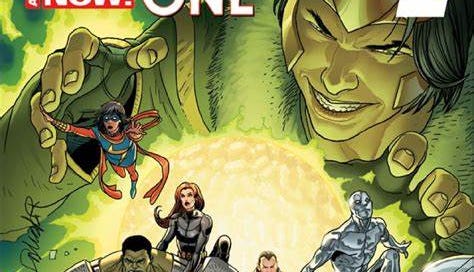



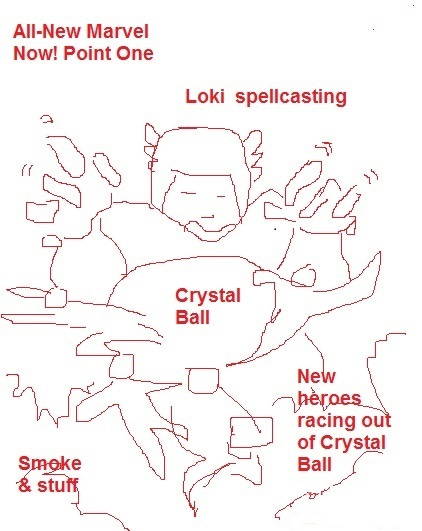
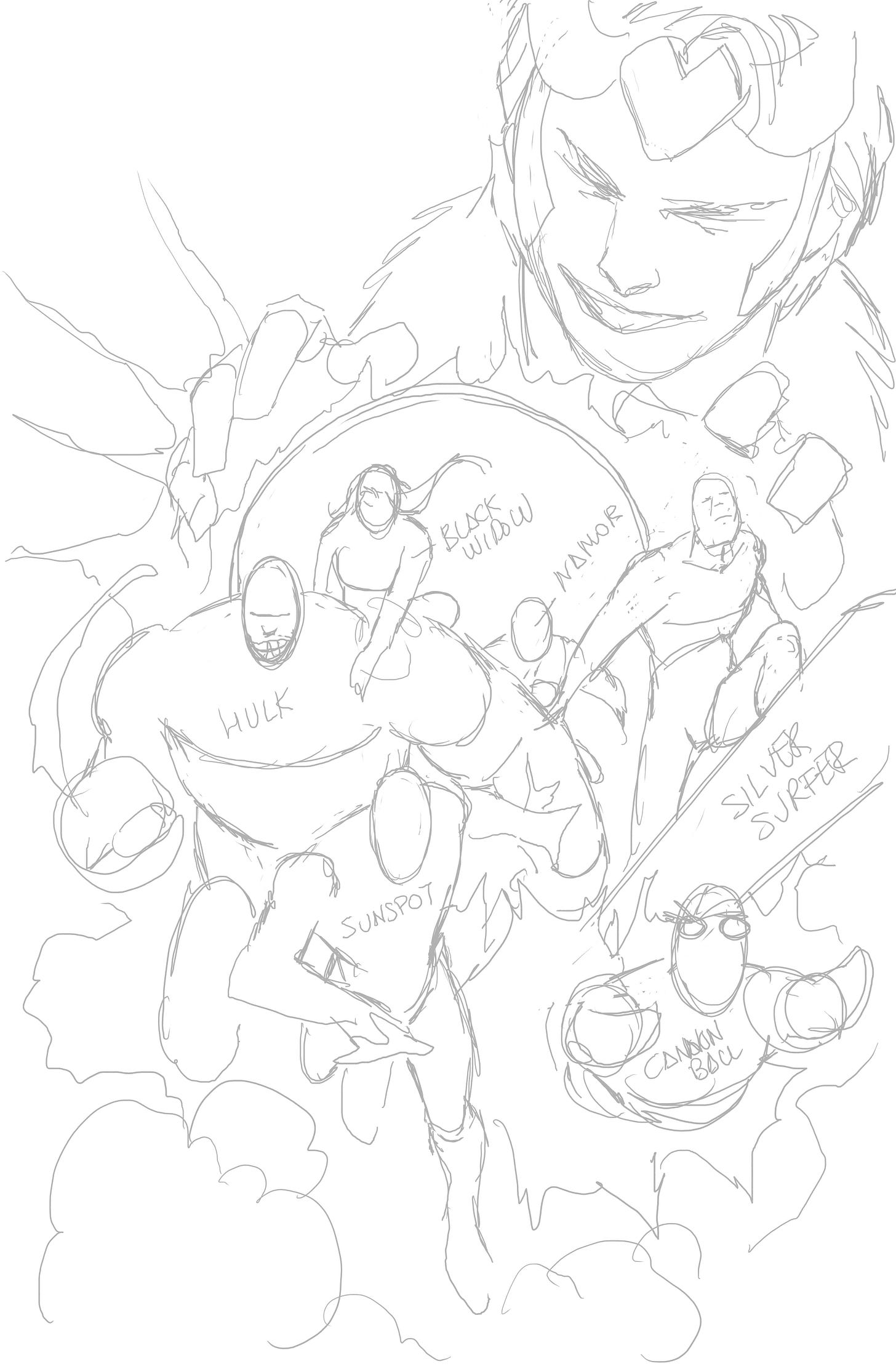

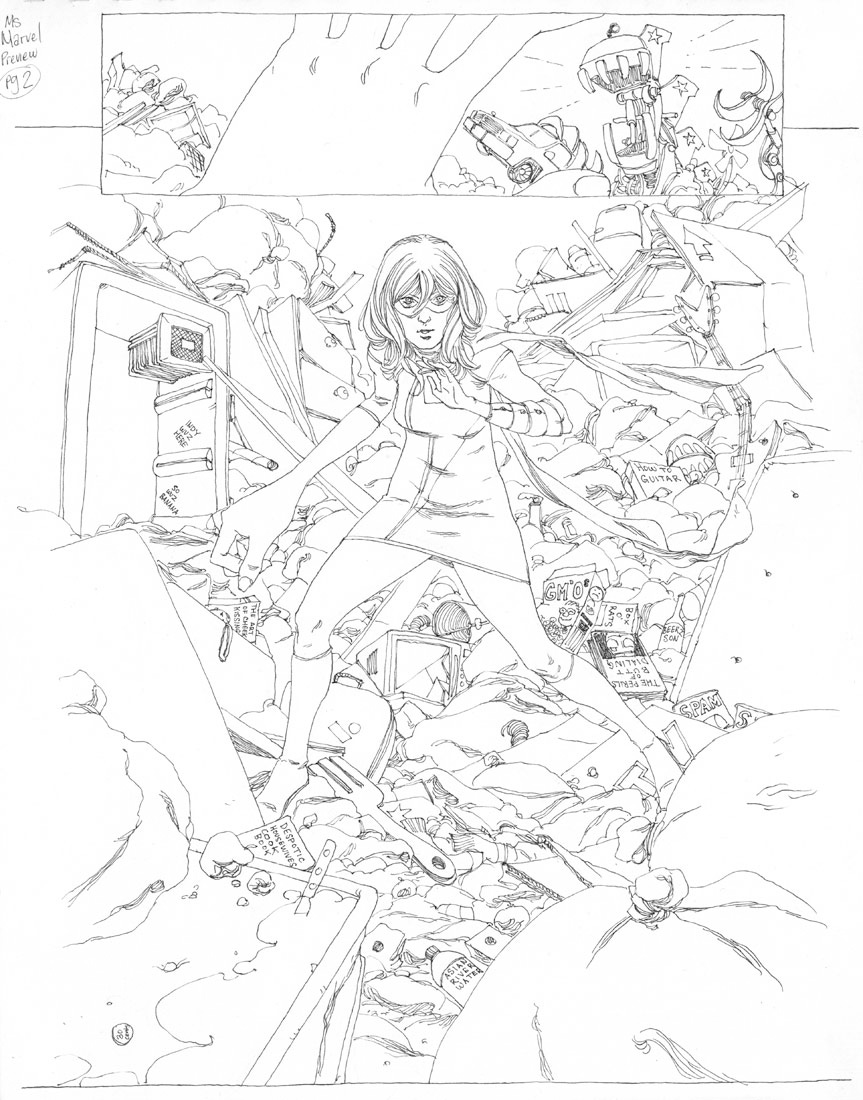

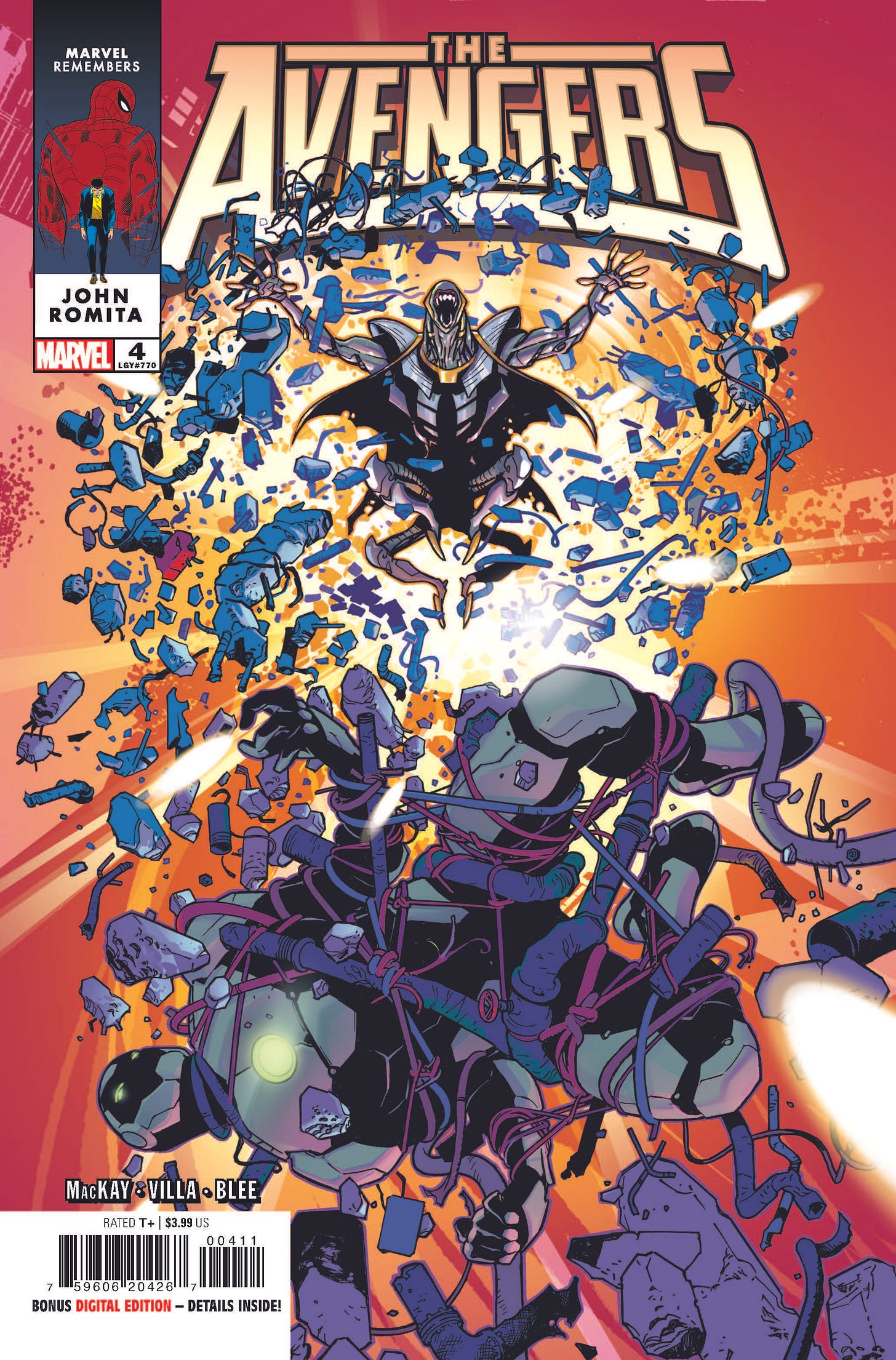


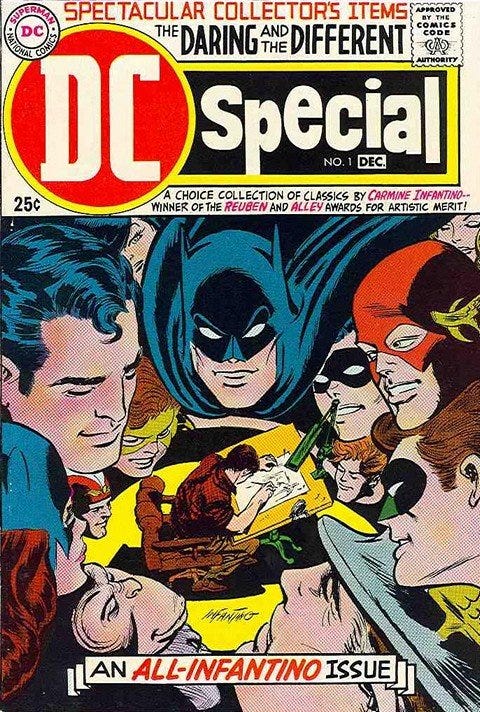
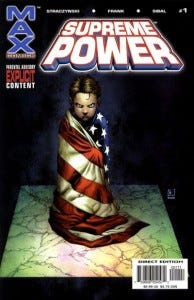
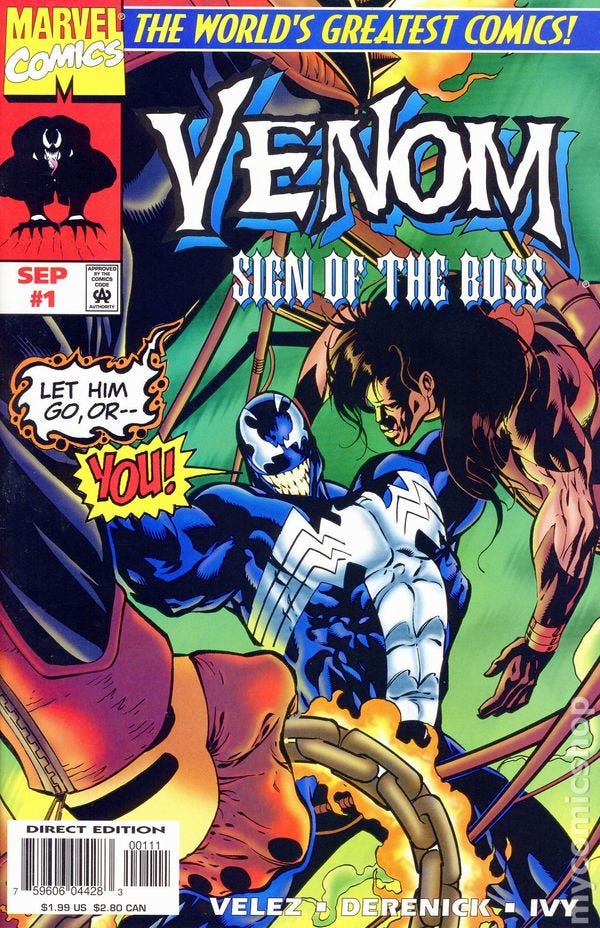

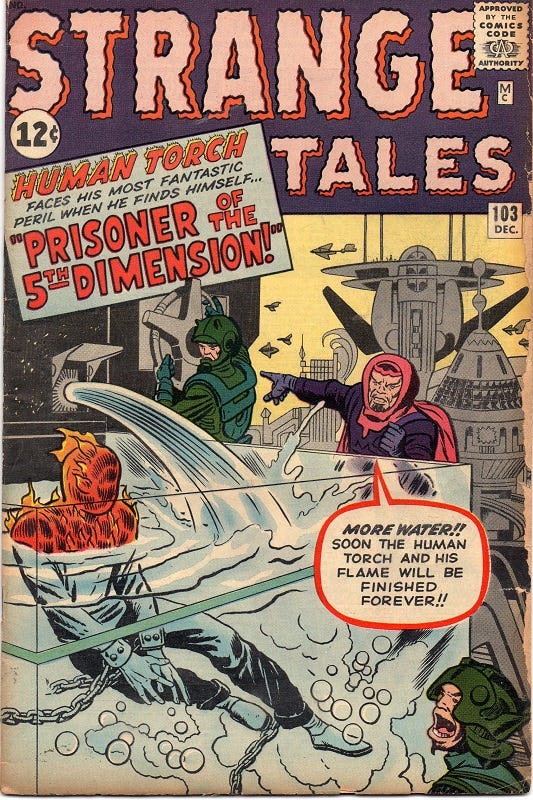

I thoroughly enjoy these, Tom! The process stuff is an extra treat this round.
I have a pretty good suspicion about what's coming based on past conversations and the specific wording you used so, obviously, CONGRATS! I'm pumped to see what you have on tap and will have more to say once things are made public.